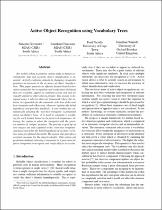JavaScript is disabled for your browser. Some features of this site may not work without it.
- ResearchSpace
- →
- Research Publications/Outputs
- →
- Conference Publications
- →
- View Item
| dc.contributor.author |
Govender, Nicolin

|
|
| dc.contributor.author |
Claassens, J

|
|
| dc.contributor.author |
Nicolls, F

|
|
| dc.contributor.author |
Warrell, J

|
|
| dc.date.accessioned | 2014-10-09T12:07:19Z | |
| dc.date.available | 2014-10-09T12:07:19Z | |
| dc.date.issued | 2013-01 | |
| dc.identifier.citation | Govender, N., Claassens, J., Nicolls, F. and Warrell, J. 2013. Active object recognition using vocabulary trees. In: IEEE Workshop on Robot Vision, Tampa, Florida, 16-18 January 2013 | en_US |
| dc.identifier.uri | http://ieeexplore.ieee.org/stamp/stamp.jsp?tp=&arnumber=6521945 | |
| dc.identifier.uri | http://hdl.handle.net/10204/7721 | |
| dc.description | IEEE Workshop on Robot Vision, Tampa, Florida, 16-18 January 2013. Post print attached. | en_US |
| dc.description.abstract | For mobile robots to perform certain tasks in human environments, fast and accurate object classification is essential. Actively exploring objects by changing viewpoints promises an increase in the accuracy of object classification. This paper presents an efficient feature-based active vision system for the recognition and verification of objects that are occluded, appear in cluttered scenes and may be visually similar to other objects present. This system is designed using a selector-observer framework where the selector is responsible for the automatic selection of the next best viewpoint and a Bayesian ‘observer’ updates the belief hypothesis and provides feedback. A new method for automatically selecting the ‘next best viewpoint’ is presented using vocabulary trees. It is used to calculate a weighting for each feature based on its perceived uniqueness, allowing the system to select the viewpoint with the greatest number of ‘unique’ features. The process is sped-up as new images are only captured at the ‘next best viewpoint’ and processed when the belief hypothesis of an object is below some pre-defined threshold. The system also provides a certainty measure for the objects identity. This system out performs randomly selecting a viewpoint as it processes far fewer viewpoints to recognise and verify objects in a scene. | en_US |
| dc.language.iso | en | en_US |
| dc.publisher | IEEE Xplore | en_US |
| dc.relation.ispartofseries | Workflow;9962 | |
| dc.subject | Mobile robots | en_US |
| dc.subject | Object recognition | en_US |
| dc.subject | Vocabulary Trees | en_US |
| dc.subject | Object recognition | en_US |
| dc.title | Active object recognition using vocabulary trees | en_US |
| dc.type | Conference Presentation | en_US |
| dc.identifier.apacitation | Govender, N., Claassens, J., Nicolls, F., & Warrell, J. (2013). Active object recognition using vocabulary trees. IEEE Xplore. http://hdl.handle.net/10204/7721 | en_ZA |
| dc.identifier.chicagocitation | Govender, Nicolin, J Claassens, F Nicolls, and J Warrell. "Active object recognition using vocabulary trees." (2013): http://hdl.handle.net/10204/7721 | en_ZA |
| dc.identifier.vancouvercitation | Govender N, Claassens J, Nicolls F, Warrell J, Active object recognition using vocabulary trees; IEEE Xplore; 2013. http://hdl.handle.net/10204/7721 . | en_ZA |
| dc.identifier.ris | TY - Conference Presentation AU - Govender, Nicolin AU - Claassens, J AU - Nicolls, F AU - Warrell, J AB - For mobile robots to perform certain tasks in human environments, fast and accurate object classification is essential. Actively exploring objects by changing viewpoints promises an increase in the accuracy of object classification. This paper presents an efficient feature-based active vision system for the recognition and verification of objects that are occluded, appear in cluttered scenes and may be visually similar to other objects present. This system is designed using a selector-observer framework where the selector is responsible for the automatic selection of the next best viewpoint and a Bayesian ‘observer’ updates the belief hypothesis and provides feedback. A new method for automatically selecting the ‘next best viewpoint’ is presented using vocabulary trees. It is used to calculate a weighting for each feature based on its perceived uniqueness, allowing the system to select the viewpoint with the greatest number of ‘unique’ features. The process is sped-up as new images are only captured at the ‘next best viewpoint’ and processed when the belief hypothesis of an object is below some pre-defined threshold. The system also provides a certainty measure for the objects identity. This system out performs randomly selecting a viewpoint as it processes far fewer viewpoints to recognise and verify objects in a scene. DA - 2013-01 DB - ResearchSpace DP - CSIR KW - Mobile robots KW - Object recognition KW - Vocabulary Trees KW - Object recognition LK - https://researchspace.csir.co.za PY - 2013 T1 - Active object recognition using vocabulary trees TI - Active object recognition using vocabulary trees UR - http://hdl.handle.net/10204/7721 ER - | en_ZA |






